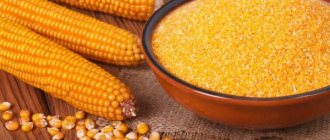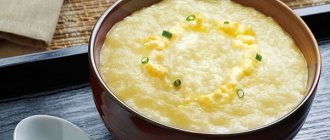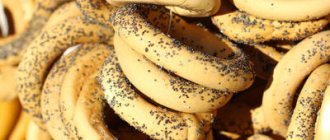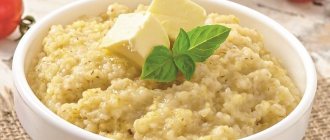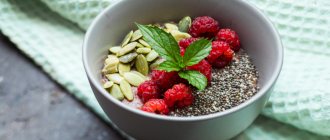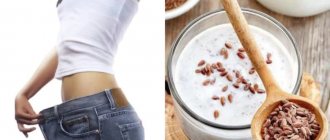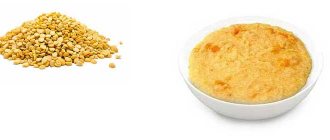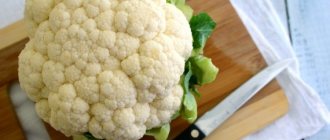Corn grits are popular in many countries due to their taste and the valuable vitamins they contain. There was a time when corn grits even replaced bread. The quality of the cereal, its taste and nutritional characteristics depend on the type of processing. Corn grain is:
- Polished (total 5 types according to grain size);
- Crushed (very fine);
- Ground into flour;
- Whole (for making popcorn, various breakfast cereals).
CALCULATORS FOR THOSE WHO WANT TO LOSE WEIGHT
Moldovans have a national dish made from corn flour - mamalyga, in Italy porridge made from corn is called polenta (Italian: Polenta), in Georgia they prepare a traditional dish from corn - gomi.
- We recommend reading: corn diet
Calorie content of corn grits porridge with milk or water
Corn porridge contains many useful elements and vitamins.
Corn porridge is a good option for those who want to lose weight or maintain normal weight . Boiled in water, it contains few calories and is well suited for this purpose.
It’s not difficult to prepare this dish: add 3 cups of water to a glass of corn grits and cook until done, adding salt to taste. The calorie content of 100 g of product will be only 75 kcal, and if you add butter, it will already be 96 kcal.
Porridge cooked with milk is the same dietary product, but its calorie content is higher. 100 g of the finished dish contains 105 kcal, and if you add butter, it will already be 120 kcal. This must be taken into account when creating a diet for those who want to lead a healthy lifestyle.
Rules for storing corn grits
The rules for storing corn grits at home are not much different from how we keep other groceries fresh. For corn you need a separate sealed container. You need to wash the cereal jar in advance; it is advisable not to pour anything into the wet one so that the cereal does not spoil. Otherwise, small quantities keep well in the kitchen cupboard at room temperature.
Coarse corn flour can be prepared directly at home. You can simply grind the cereal in a regular coffee grinder to get this healthy product.
If the cereal is sprouted, the result should not be stored for more than 1-2 days. Corn seedlings quickly outgrow. And if you leave them in a warm room, they also “attract” mold.
Composition and properties of chemical elements and vitamins in corn porridge
The content of the main elements in the finished porridge is as follows:
- carbohydrates – 56%,
- proteins – 12%,
- fats – 2%,
- dietary fiber - 25%.
Due to the presence of amino acids in the product, such as lysine, arginine, tryptophan and others, protein is broken down and absorbed in the body, and folic acid contained in the porridge is recommended for women during pregnancy.
The content of microelements in cereals per 100 grams of product is given in the table:
| Name | Content, mg |
| Potassium | 147 |
| Calcium | 20 |
| Magnesium | 36 |
| Phosphorus | 109 |
| Iron | 2,69 |
| Iodine | 5,2 |
| Manganese | 400 |
| Copper | 210 |
| Chromium | 0,5 |
Corn porridge is a good option for those who want to lose weight or maintain normal weight.
Useful properties of some components:
- Calcium protects gums and enamel from damage.
- Retinol helps preserve vision. The dish is especially useful for those who work at the computer.
- For patients with cardiovascular diseases, the food is beneficial due to its high potassium content. It acts as a prophylactic against cardiac arrhythmia and blood pressure disorders.
- 10% of people in the world suffer from food allergies caused by gluten. Corn does not contain gluten, so it does not cause allergies.
- The presence of iron promotes the growth of hemoglobin and reduces the possibility of developing anemia.
- Vitamin A and E help the skin remain elastic, strengthen nails and promote hair growth.
- Vitamin C prevents the development of rickets.
Be sure to read: How many calories are in lavash: what does it depend on, the calorie content of 1 sheet and per 100 grams, is it possible when losing weight?
Chemical composition and nutritional value of corn grits
All types of cereals contain a large amount of mineral elements and vitamins. All are very nutritious and healthy. Corn grits are no exception. True, in nutritional value it is inferior to other species. But it does not contain gluten, so it can be eaten by people who are allergic to this substance.
Plant fibers make cereal very useful for the digestive system, fiber plays the role of a gastrointestinal health worker. There are few proteins and fats in it, so their properties are almost not expressed.
It is not very rich in B vitamins, but it does contain biotin and vitamins A, C and E.
The benefits of corn porridge
Corn porridge is useful for all categories: children, adults and the elderly.
Useful properties for weight loss
Dietary plant fibers swell in the stomach, filling it. They create a feeling of fullness and suppress hunger.
Corn porridge for children
The dish begins to be given to the child from 9 months. It is advisable that by this time the child is already accustomed to porridges made from other cereals, such as buckwheat and rice. First, the porridge is cooked from crushed cereals, which you can prepare yourself using a coffee grinder.
It is necessary to accustom a child to such food gradually. Initially, give 1-2 teaspoons during your regular breakfast. The next day, if there is no allergy, the dose is doubled, gradually bringing it to the norm of 150 g at 9 months and 200 g at 1 year.
It is recommended to give porridge 1-2 times a week, and after one year of age add a little butter and sugar, and mix with chopped fruits or vegetables. You can cook food with water or milk, if milk does not cause digestive problems in the child.
Corn porridge for pregnant and nursing mothers
Corn porridge begins to be given to a child starting from 9 months.
The product is useful from the first months of pregnancy until childbirth. The frequency of taking corn porridge is 2-3 times a week.
After childbirth, when the baby’s ventricle has not yet fully formed, the mother should limit her consumption of porridge so as not to cause indigestion and colic in the baby. In the first months, mother should adhere to strictly dietary foods and only then gradually switch to a regular diet.
But not all pregnant women can eat this dish.
The fact is that expectant mothers experience an increase in blood viscosity before giving birth. This is a natural process, but there is a category of people with increased clotting. Eating corn porridge is unsafe for such people, as blood clots may form on the blood vessels.
Be sure to read: How many calories are in one pancake with different types of filling and a recipe for diet pancakes for following a diet
Corn porridge for the elderly
Corn contains the following elements that are beneficial for older people:
- calcium (strengthens bones);
- dietary fiber (remove harmful substances from the stomach, increase the motor function of the stomach);
- potassium (improves the functioning of the cardiovascular system);
- iron (increases hemoglobin levels);
- iodine (improves memory).
Useful properties of corn grits
Porridge and other cornmeal dishes are a good source of complex carbohydrates. In today's weight-loss-obsessed world, a simple fact is somehow glossed over. For the normal functioning of the human central nervous system, as much as 140 g of pure carbohydrates per day are required. Who sits in our “drying rooms” so often that they hardly know their bearings in time and space, confuse the days, forget their keys, and get lost in the list of to-dos and appointments? Anyone who does this should know that the central nervous system can take brutal revenge for neglecting its needs. And okay, the speed of mental activity will not be up to par, and the coordination of movements of the beautiful body, for which everyone is killing so much, will be disrupted. How do you like dry abs on flexing legs in tandem with “very differently” moving arms? What about sleep disorders?
To avoid all this, you should include sources of carbohydrates in your diet. Corn porridge or even just flour is good because it contains complex carbohydrates. They are absorbed slowly and release energy gradually. You shouldn’t be afraid to eat them if your goal is to lose weight. Even the most strict diets can contain up to 2-3 g of carbohydrates per 1 kg of weight per day. What about sports diets with 3 g of protein and 1.5 g of carbohydrates? Isn’t it time to throw out the corn porridge? No, it’s not time, at least if you are exercising for health and beauty, and not for the sake of a medal and a can of questionable quality protein. In fact, it is difficult to say that the human body optimally absorbs the notorious 3 g of protein per kilogram of body weight, and uses it specifically for building muscles. On the contrary, in a situation of carbohydrate deficiency, “construction” usually does not occur. So those who strive for beauty and health should definitely eat porridge.
How much corn grits can a girl eat without gaining weight? The question is purely theoretical, and the answer depends on weight and occupation. On average, a girl can eat about 30-33 kcal per kilogram of her own weight, if we are not talking about a professional athlete. How much of this should you “give away” to carbohydrates? At least 2-3 g per kilogram of body weight if you are losing weight, or a little more if you maintain your weight.
What is the best way to digest corn grits? The product is rich in fiber, so many people may experience digestive problems if the porridge is heavily flavored with fibrous vegetables and tough meat. It is worth starting to introduce cereals into the diet, oddly enough, along with white fish or poultry. In the future, just monitor the individual characteristics of the body.
It cannot be said that corn porridge, say, is better than buckwheat. It's just different - it contains more vitamin A, a little vitamin E and is a natural antioxidant. Corn grits can also serve as an excellent basis for the production of flour. Natural corn flour bakes very well, you can use it to prepare a variety of pancakes, add it to pies and cheesecakes. Flour is also the quickest way to cook porridge for baby food.
Corn grits are traditional in the Mexican and American diet. However, what we consider porridge is rarely consumed “solo” there. Mexican cuisine is characterized, rather, by tortillas made from corn flour of various configurations, and the addition of corn grains to complex mixed dishes, in which there is also a place for legumes. And sometimes - meat.
It is believed that corn together with beans provides a more complete set of amino acids than just one type of these products. Cereals are often added to vegetarian diets and are actively used to obtain complete protein.
Corn porridge is recommended for baby food. There is no consensus on diabetes. Whole grain corn has a lower GI than white rice, but flour has a fairly high GI if the grind is fine. Whole grains are recommended for diabetics, but flour is not always recommended.
Corn porridge is actively used in various diets for weight loss. The cooked product has a fairly low calorie content when “transferred” into portions. Many people claim that corn porridge has helped them satisfy their sugar cravings while losing weight.
Corn flour is good because it allows you to almost completely do without the more “harmful” (or rather, useless, vitamin-poor) wheat flour. Many health foods, such as breads and breakfast foods, are made from corn rather than wheat.
There is also a mono-diet based on corn porridge. It cannot be called useful, but its supporters believe that in order to reduce weight by 3-4 kg per week, it is worth limiting your diet to a glass of corn grits per day. It is worth remembering that, unlike buckwheat and millet, corn is poorly cooked, and the amount of food obtained is very small. So, of all the cereal mono-diets, corn is almost the strictest.
Features of eating corn porridge
Healthy people can eat corn porridge without restrictions , although nutritionists recommend 2-3 times a week.
But people suffering from various diseases may experience problems with uncontrolled nutrition. Therefore, it is better to consult your doctor first.
For gastritis
The diet of patients with gastritis is meager; they are forced to give up many dishes so that the level of acid in the intestines is normal. Porridge will not cause harm, it can be eaten for breakfast or lunch, and the dietary fiber contained in the product will help improve the functioning of the stomach and remove accumulated toxins.
But there are also restrictions: the product cannot be eaten during an exacerbation of the disease. It is allowed to take it when the attack passes. The dish is consumed warm; if the porridge is thick, then it is diluted.
For pancreatitis
A person who suffers from chronic pancreatitis can eat porridge when there is no exacerbation of the disease.
You can still introduce corn porridge into your diet, but only in small portions
The product contains large amounts of coarse dietary fiber, and even prolonged cooking does not make it softer. The patient's pancreas becomes sensitive and irritable, so rough food can cause an attack of pancreatitis.
You can still introduce corn porridge into your diet, but only in small portions, and if undesirable symptoms appear, then you should temporarily exclude this product from the menu and consult your doctor.
For diabetes
The diet for patients with type 2 diabetes is developed taking into account the glycemic index, abbreviated as GI.
This is an indicator of blood glucose levels after a meal. Corn porridge has a GI of 50. This means that this product is safe and can be included in the diet.
Eating porridge helps diabetic patients fight excess weight; the dish saturates the body, is digested slowly and dulls the feeling of hunger.
The benefits and harms of the dish
Systematic inclusion of corn porridge in the diet makes it possible not only to significantly improve your health, but also to launch weight loss processes to a higher level.
The benefits of corn porridge are:
- High content of minerals and proteins;
- Unsaturated fatty acids in the composition to accelerate the breakdown of fat;
- Complex carbohydrates to increase satiety and reduce blood sugar spikes;
- Fiber in the composition to normalize intestinal motility.
But despite the undeniable benefits, uncontrolled consumption of the dish can lead to unpleasant consequences:
- Weight gain. Due to the high energy value, a calorie surplus is possible, as a result of which weight loss has the opposite effect;
- In case of exacerbation of diseases of the gastrointestinal tract, eating corn porridge is undesirable. Due to the fiber in the composition, intestinal activity increases, this further irritates the delicate mucous membrane of the organs;
- If you have diabetes, it is also undesirable to actively rely on this product due to possible insulin spikes.
But the beneficial properties significantly outweigh the negative consequences when corn grits are included in the diet. The main factor is to pay attention to the characteristics of your body and not overuse the product.
How to make healthy porridge from corn grits
A healthy cereal dish is cooked in water without adding additives: oil, sugar, meat, fruit. Only such a dietary product will bring maximum benefit to the body.
The most delicious and soft porridge is obtained if you cook the cereal in a slow cooker.
The process consists of the following steps:
- Rinse the cereal until the water becomes clear and pour into the multicooker container.
- Fill with water, add salt to taste.
- Set the time (1 hour) and operating mode (“Porridge”) on the multicooker panel.
- After finishing the cooking process, try the dish. If the cereal grains are not cooked well, extend the cooking time for another 20 minutes.
Harm of corn porridge and contraindications
Any useful product can be harmful if consumed contrary to the recommendations of specialists and in unlimited quantities.
Corn products are prohibited:
- People with gastrointestinal ulcers. They can provoke the development of the disease.
- People with dystrophy. The food contains few calories, but gives a feeling of fullness.
- For constipation and heaviness in the abdominal area.
- People with low fibrinogen levels.
- Infants up to 9 months.
Eating porridge too often will not be beneficial and may have a bad effect on the stomach - it will become heavier. It is also possible to gain weight, despite the dietary properties of the product.
How to make hominy from corn grits
Mamalyga from corn grits
Mamalyga (corn cake) is a common dish in Georgia and Moldova . The flatbread is considered the second bread. Cooking time is about an hour; it is better to cook the dish in a cauldron.
Cooking steps:
- For 2 cups of cereal take 6 cups of water. Place the cauldron on the fire, pour in water and add a little cereal and salt.
- When the water boils, pour the remaining grain into the cauldron in a stream, stirring continuously all the time.
- When cooking, the mamalyga will begin to thicken in the cauldron, then, while stirring with a spoon, separate the porridge from the walls of the vessel.
- The stirring process continues throughout the cooking time, with the addition of a spoonful of olive oil or butter.
It turns out to be a round flatbread, which is used instead of bread.
Harm of corn grits
Typically, sources indicate that corn grits can cause allergies. As a product rich in fiber, corn grits are not recommended for exacerbation of pancreatitis, as well as gastrointestinal diseases. Corn grits are considered heavy food for people prone to flatulence.
But discussions about sugar (natural, not added granulated sugar) in corn grits and its harm for weight loss should not be taken seriously. If you eat porridge in moderation, there will be no harm from it. But eating porridge alone can be fraught with a deterioration in the functioning of the immune system due to a deficiency of essential amino acids and a rapid “getting rid” of muscle tissue.
Types of cereals, selection and storage
Cereals are available in two types: polished and crushed. In turn, ground grains have 5 grinding levels, the finest is No. 5, the coarsest is No. 1. Crushed grits are used to make corn flakes, and polished grits are supplied to the retail chain.
Cereals should be stored in a cool place in fabric bags or paper bags.
But during storage, moths or bugs may appear in the cereal, so from time to time it is necessary to carry out a preventive inspection of the cereal. If pests are found, then bake the cereal on a baking sheet in the oven.
